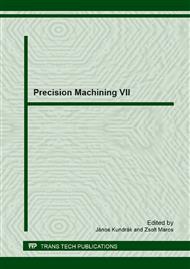[1]
P.K. Mehrotra, Applications of ceramic cutting tools, Key Engineering Materials 138-140 (1997) 1-24.
DOI: 10.4028/www.scientific.net/kem.138-140.1
Google Scholar
[2]
W. Grzesik, T. Wanat, Surface finish generated in hard turning of quenched alloy steel parts using conventional and wiper ceramic inserts, International Journal of Machine Tools and Manufacture 46 (2006) 1988-(1995).
DOI: 10.1016/j.ijmachtools.2006.01.009
Google Scholar
[3]
W. Zębala, J. Siwiec, Hard turning of cold work tool steel with CBN tools, Advances in manufacturing science and technology 36/4 (2012) 19-32 (ISSN 1895-9881) DOI: 10. 2478/v10264-012-0023-2.
Google Scholar
[4]
R. Tanaka, A. Hosokawa, T. Furumoto. T. Ueda, Cutting performance of ceramic tools in turning of mild steel, Key Engineering Materials 523-524 (2012) 493-496.
DOI: 10.4028/www.scientific.net/kem.523-524.493
Google Scholar
[5]
X.B. Cui, J. Zhao, Y.H. Zhou, Z.Q. Pei, Cutting forces and tool wear in intermittent turning processes with Al2O3-based ceramic tools, Key Engineering Materials, 499 (2012) 205-210.
DOI: 10.4028/www.scientific.net/kem.499.205
Google Scholar
[6]
W.S. Lin, The study of high speed turning of the hardened mold steel SKD11 by ceramic cutting tools, Key Engineering Materials 364-366 (2007) 1015-1020.
DOI: 10.4028/www.scientific.net/kem.364-366.1015
Google Scholar
[7]
W. Zębala, Modelling researches of the vibrations influence on the cutting process, Advances in Manufacturing Science and Technology, 29/4 (2005) 99-107 (ISSN 0137-4478).
Google Scholar
[8]
J. Kundrák, G. Varga, Possibility of reducing environmental load in hard machining. Key Engineering Materials 496 (2011) 205-210.
DOI: 10.4028/www.scientific.net/kem.496.205
Google Scholar
[9]
Z.Q. Liu, J.M. Wang, Y. Wan, Machinability for turning of 1CR18NI9TI austenitic stainless steel with ceramic tool, Key Engineering Materials 315-316 (2006) 584-587.
DOI: 10.4028/www.scientific.net/kem.315-316.584
Google Scholar
[10]
C. Felho, J. Kundrák, Characterization of topography of cut surface based on theoretical roughness indexes, Key Engineering Materials 496 (2011) 194-199.
DOI: 10.4028/www.scientific.net/kem.496.194
Google Scholar
[11]
W. Zębala, Tool stiffness influence on the chosen physical parameters of the milling process, Bulletin of the Polish Academy of Science-Technical Sciences 60/3 (2012) 597-604. DOI: 10. 2478/v10175-012-0071-0.
DOI: 10.2478/v10175-012-0071-0
Google Scholar
[12]
Z.L. Han, B. Lin, B.X. Zhang, L. Zhang, Design optimization of cutting parameters in turning 45Cr steel using cermets tool, Key Engineering Materials 443 (2010) 238-243.
DOI: 10.4028/www.scientific.net/kem.443.238
Google Scholar
[13]
M. Nalbant, H. Gökkaya, G. Sur, Application of Taguchi method in the optimization of cutting parameters for surface roughness in turning, Materials and Design 28 (2007) 1379-1385.
DOI: 10.1016/j.matdes.2006.01.008
Google Scholar
[14]
A.R. Motorcu, The Optimization of Machining Parameters Using the Taguchi Method for Surface Roughness of AISI 8660 Hardened Alloy, SteelStrojniški vestnik - Journal of Mechanical Engineering 56-6 (2010) 391-401.
Google Scholar
[15]
Information on http: /www. iscar. com.
Google Scholar
[16]
W. Zębala, B. Słodki, Cutting data correction in Inconel 718 turning, International Journal of Advanced Manufacturing Technology 65/5-8 (2013) 881-893. DOI 10. 1007/s00170-012-4225-x.
DOI: 10.1007/s00170-012-4225-x
Google Scholar


